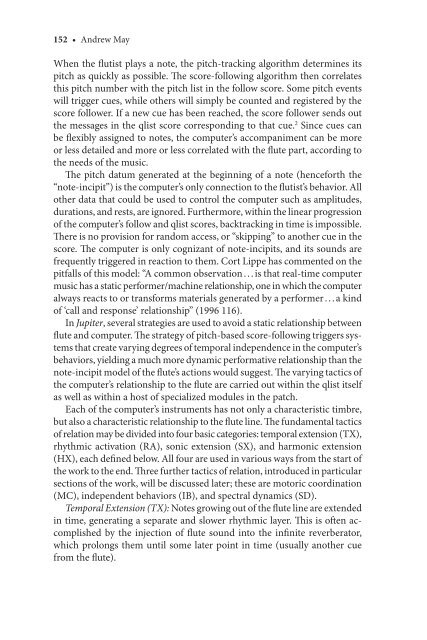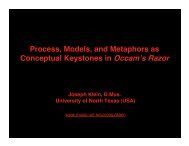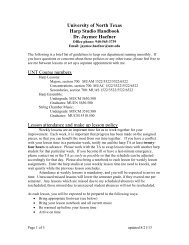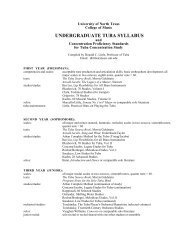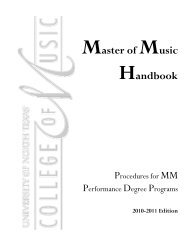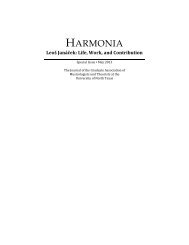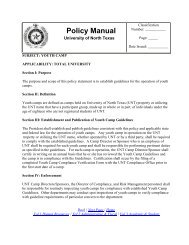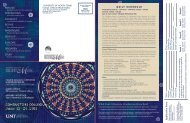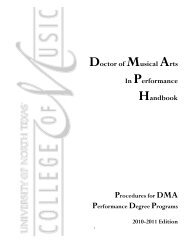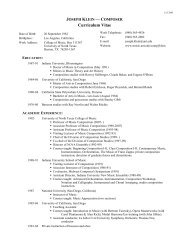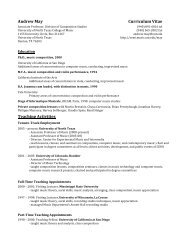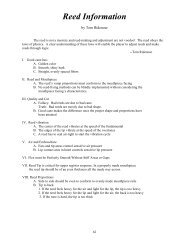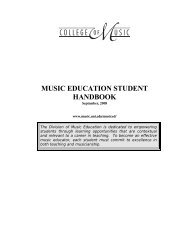7 Philippe Manoury's Jupiter1
7 Philippe Manoury's Jupiter1
7 Philippe Manoury's Jupiter1
You also want an ePaper? Increase the reach of your titles
YUMPU automatically turns print PDFs into web optimized ePapers that Google loves.
152 • Andrew May<br />
When the fl utist plays a note, the pitch-tracking algorithm determines its<br />
pitch as quickly as possible. Th e score-following algorithm then correlates<br />
this pitch number with the pitch list in the follow score. Some pitch events<br />
will trigger cues, while others will simply be counted and registered by the<br />
score follower. If a new cue has been reached, the score follower sends out<br />
the messages in the qlist score corresponding to that cue. 2 Since cues can<br />
be fl exibly assigned to notes, the computer’s accompaniment can be more<br />
or less detailed and more or less correlated with the fl ute part, according to<br />
the needs of the music.<br />
Th e pitch datum generated at the beginning of a note (henceforth the<br />
“note-incipit”) is the computer’s only connection to the fl utist’s behavior. All<br />
other data that could be used to control the computer such as amplitudes,<br />
durations, and rests, are ignored. Furthermore, within the linear progression<br />
of the computer’s follow and qlist scores, backtracking in time is impossible.<br />
Th ere is no provision for random access, or “skipping” to another cue in the<br />
score. Th e computer is only cognizant of note-incipits, and its sounds are<br />
frequently triggered in reaction to them. Cort Lippe has commented on the<br />
pitfalls of this model: “A common observation . . . is that real-time computer<br />
music has a static performer/machine relationship, one in which the computer<br />
always reacts to or transforms materials generated by a performer . . . a kind<br />
of ‘call and response’ relationship” (1996 116).<br />
In Jupiter, several strategies are used to avoid a static relationship between<br />
fl ute and computer. Th e strategy of pitch-based score-following triggers systems<br />
that create varying degrees of temporal independence in the computer’s<br />
behaviors, yielding a much more dynamic performative relationship than the<br />
note-incipit model of the fl ute’s actions would suggest. Th e varying tactics of<br />
the computer’s relationship to the fl ute are carried out within the qlist itself<br />
as well as within a host of specialized modules in the patch.<br />
Each of the computer’s instruments has not only a characteristic timbre,<br />
but also a characteristic relationship to the fl ute line. Th e fundamental tactics<br />
of relation may be divided into four basic categories: temporal extension (TX),<br />
rhythmic activation (RA), sonic extension (SX), and harmonic extension<br />
(HX), each defi ned below. All four are used in various ways from the start of<br />
the work to the end. Th ree further tactics of relation, introduced in particular<br />
sections of the work, will be discussed later; these are motoric coordination<br />
(MC), independent behaviors (IB), and spectral dynamics (SD).<br />
Temporal Extension (TX): Notes growing out of the fl ute line are extended<br />
in time, generating a separate and slower rhythmic layer. Th is is oft en accomplished<br />
by the injection of fl ute sound into the infi nite reverberator,<br />
which prolongs them until some later point in time (usually another cue<br />
from the fl ute).<br />
Simoni_RT76294_C007.indd 152 9/22/2005 11:19:18 AM


